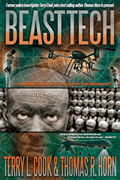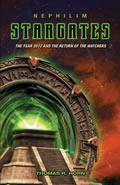PART 12
By Thomas R. Horn
January 7, 2014
NewsWithViews.com
Most
readers are undoubtedly familiar with the development of radio-frequency
identification (rfid) technology that, under certain applications,
is forecast to be connected to future human-enhancement technologies,
 especially
neurosciences, brain-machine interfacing, and cybernetics.
especially
neurosciences, brain-machine interfacing, and cybernetics.
This rfid tech employs tiny integrated circuits for storing and processing information using an antenna for receiving and transmitting the related data. This technology is most commonly applied as a “tag” for tracking inventory with radio waves at companies like Walmart, where consumer goods are embedded with “smart tags” that are read by handheld scanners for supply-chain management.
In recent years, rfid technology has been expanding within public and private firms as a method for verifying and tracking people as well. We first became aware of this trend a while back when a chief of police—Jack Schmidig of Bergen County, New Jersey, a member of the police force for more than thirty years—received a VeriChip (rfid chip) implant as part of Applied Digital Solution’s strategy of enlisting key regional leaders to accelerate adoption of its product.
Kevin H. McLaughlin (chief executive officer of VeriChip Corp. at the time) said of the event that “high-profile regional leaders are accepting the VeriChip, representing an excellent example of our approach to gaining adoption of the technology” (note that VeriChip Corp. was renamed to PositiveID Corp. on November 10, 2009, through the merger of VeriChip Corp. and Steel Vault Corp.). Through a new and aggressive indoctrination program called “Thought and Opinion Leaders to Play Key Role in Adoption of VeriChip,” the company set out to create exponential adoption of its FDA-cleared, human-implantable rfid tag.
According to information released by the company, the implantable transceiver “sends and receives data and can be continuously tracked by GPS (Global Positioning Satellite) technology.” The transceiver’s power supply and actuation system are unlike anything ever created. When implanted within a body, the device is powered electromechanically through the movement of muscles and can be activated either by the “wearer” or by the monitoring facility. In the wake of the terrorist attacks in New York City and Washington, DC, an information technology report highlighted the company’s additional plans to study implantable chips as a method of tracking terrorists. “We’ve changed our thinking since September 11 [2001],” a company spokesman said. “Now there’s more of a need to monitor evil activities” (“Will You Grin for the rifd Mark of the Beast?” Before It’s News, October 26, 2010).
As a result, PositiveID has been offering the company’s current incarnation of implantable rfid as “a tamper-proof means of identification for enhanced e-business security¼tracking, locating lost or missing individuals, tracking the location of valuable property [this includes humans], and monitoring the medical conditions of at-risk patients.” While PositiveID offers testimony that safeguards have been implemented to ensure privacy in connection with its implantable microchips, some believe privacy is the last thing internal radio transmitters will protect—that, in fact, the plan to microchip humanity smacks of the biblical Mark of the Beast. Has an end-times spirit indeed been pushing for adoption of this technology this generation?
Consider the following:
• According to some Bible scholars, a biblical generation is forty years. This is interesting, given what we documented in our book, Zenith 2016: Did Something Begin in the Year 2012 that Will Reach Its Apex in 2016?, concerning the Jewish Calendar year 5773 (2012—2013), from which, counting backward forty years, one arrives at the year 1973, the very year Senior Scholastics began introducing school kids to the idea of buying and selling in the future using numbers inserted in their foreheads. In the September 20, 1973, feature “Who Is Watching You?” the secular high school journal speculated:
All buying and selling in the program will be done by computer. No currency, no change, no checks. In the program, people would receive a number that had been assigned them tattooed in their wrist or forehead. The number is put on by laser beam and cannot be felt. The number in the body is not seen with the naked eye and is as permanent as your fingerprints. All items of consumer goods will be marked with a computer mark. The computer outlet in the store which picks up the number on the items at the checkstand will also pick up the number in the person’s body and automatically total the price and deduct the amount from the person’s “Special Drawing Rights” account.
• The following year, the 1974 article, “The Specter of Eugenics,” had Charles Frankel documenting Nobel Prize-winner Linus Pauling’s suggestions that a mark be tattooed on the foot or forehead of every young person. Pauling envisioned a mark denoting genotype.
• In 1980, US News and World Report revealed that the federal government was plotting “National Identity Cards” without which no one could work or conduct business.
• The Denver Post Sun followed up in 1981, claiming that chip implants would replace the identification cards. The June 21, 1981, story read in part, “The chip is placed in a needle which is affixed to a simple syringe containing an anti-bacterial solution. The needle is capped and ready to forever identify something—or somebody” (“Will You Grin for the RFID Mark of the Beast?”).
• The May 7, 1996, Chicago Tribune questioned the technology, wondering aloud if we would be able to trust “Big Brother under our skin?”
• Then, in 1997, applications for patents of subcutaneous implant devices for “a person or an animal” were filed.
• In August 1998, the BBC covered the first-known human microchip implantation.
• That same month, the Sunday Portland Oregonian warned that proposed medical identifiers might erode privacy rights by tracking individuals through alphanumeric health-identifier technologies. The startling Oregonian feature depicted humans with barcodes in their foreheads
• Millions of Today Show viewers then watched in 2002 when an American family got “chipped” with Applied Digital Solution’s VeriChip live from a doctor’s office in Boca Raton, Florida.

Getting "Chipped"
on the Today Show
• In November of the same year, IBM’s patent application for “identification and tracking of persons using rfid-tagged items” was recorded.
• Three years later, former secretary of the Health and Human Services department, Tommy Thompson, forged a lucrative partnership with VeriChip Corp. and began encouraging Americans “to get chipped” so that their medical records would be “inside them” in case of emergencies.
• The state of Wisconsin—where Thompson was governor before coming to Washington—promptly drew a line in the sand, passing a law prohibiting employers from mandating that their employees get “chipped.” Other states since have passed or are considering similar legislation. Despite this, in the last decade, an expanding number of companies and government agencies has started requiring the use of rfid for people identification. Unity Infraprojects, for example, one of the largest civil contractors in India, tracks its employees with rfid, as does the US Department of Homeland Security for workers involved in baggage handling at airports.
• Since September 11, 2001, the US government has proposed several versions of a national ID card that would use rfid technology.
• Since 2007, the US government began requiring all passports to include rfid chips that enable use of biometric features such as facial recognition.
Hundreds of Alzheimer’s patients have been injected with implantable versions of rfid tags in recent years.
• Rfid bracelets are now being placed on newborns at a growing list of hospitals.
• Students are being required in some schools and universities to use biometric ID employing rfid for electronic monitoring.
• Thousands of celebrities and government officials around the world have had rfid radio chips implanted in them so that they can be identified—either for entry at secure sites or for identification if they are kidnapped or killed.
• Others, like Professor Kevin Warwick (a British scientist and professor of cybernetics at the University of Reading in the United Kingdom), have been microchipped for purposes of controlling keypads and external devices with the wave of a hand.
• Besides providing internal storage for individual-specific information like health records, banking and industry envisions a cashless society in the near future where all buying and selling could transpire using a version of the subdermal chips and wireless authentication. As mentioned above, in 1973, Senior Scholastics magazine introduced school-age children to the concept of buying and selling using numbers inserted in their foreheads. More recently, Time magazine, in its feature story, “The Big Bank Theory and What It Says about the Future of Money,” recognized that this type of banking and currency exchange would not require a laser tattoo. Rather, the writer said, “Your daughter can store the money any way she wants—on her laptop, on a debit card, even (in the not-too-distant future) on a chip implanted under her skin” (Joshua Ramo, “The Big Bank Theory,” Time, April 27, 1998).
• In 2007, PositiveID, which owns the Food and Drug Administration-approved VeriChip that electronically transmits patients’ health information whenever a scanner is passed over the body, ominously launched “Xmark” as its corporate identity for implantable healthcare products.
• Skip forward to the present, and suddenly the push for a national biometric identification system and rfid technology is all over the news and within industry trade reports. The Next Generation Biometric Market—Global Forecast & Analysis 2012–2017 noted that the global biometric identification market was surging toward the nearly $14 billion mark by 2017, with an estimated compound annual growth rate of 18.7 percent.
• In February 2013, a report for the Competitive Enterprise Institute authored by David Bier (“The New National Identification System Is Coming”) documented how US lawmakers including Senator John McCain and Senator Lindsay Graham were advocating for a “super” identification system that would include biometrics.
• Three months later, in May, the Massachusetts-based engineering firm MC10 disclosed that it is developing a high-tech, biostamp, electronic “tattoo” that will replace all passwords. It is made of silicon and is sealed on the wearer’s body. As this book heads to the editor, MC10 hopes to have its first prototypes “affixed” to humans with the next few months.

Executives
At MC10 With DARPA Representatives Rolling Out High Tech Tattoos As
Tomorrow's ID
• Simultaneously, Motorola Senior Vice President Regina Dugan announced that a project similar to MC10’s is now under development at the multinational telecommunications company. Called “The Proteus Digital Pill,” the project contains a computer chip and transmits an 18-bit, ECG-like signal that can communicate with mobile devices as well as serve as a biometric ID. The ingestible “pill” has already been approved for human use and tracking by the FDA in the United States as well as in Europe. Note that “Proteus” is a shape-shifter and primordial pagan god of ancient sages (seers) that can affect the “conscious” and is capable of mutating the host.
• No sooner had Motorola announced its plan for the “Proteus” swallowable marker than some in the secular media marched forward to brand any concerned or resistant religious types (such as the authors of this book) as inflexible shrills who do not represent true Christianity. As an example, Iain Thomson of The Register wrote on May 31, 2013:
One marketing problem Motorola may not have anticipated is the reaction of biblical literalists to its…authentication systems.
A surprising number of people in the US still adhere to an apparent literal translation of the current version of…the finale of the New Testament: The Book of Revelation—or, for you believers of the Catholic persuasion, The Apocalypse.
The text, thought to be written about 60 years after the biblical death of Christ, is regarded as either a description of the end times of humanity, a satirical pastiche on the increasingly subverted tenets of Christian bureaucracy, or a really bad mushroom trip on a Greek island. Nevertheless it contains the following warning:
“And he causeth all, both small and great, rich and poor, free and bond, to receive a mark in their right hand, or in their foreheads: And that no man might buy or sell, save he that had the mark, or the name of the beast, or the number of his name.”
Be reassured that the majority of people of faith in the US and elsewhere aren’t quite so inflexible. Those that aren’t may be shrill, particularly in the US, but do not form a representative sample of Christianity.
• In January, 2013, Robert A. Pastor, professor of international relations at American University, argued before the US Congress that the majority of Americans are now ready for—and need—a national ID based on head and hand biometrics. A centerpiece of the immigration bill imagines just such a scenario and would require all citizens to have a biometric card, without which no one would be approved for employment (effectively rendering him or her as a “non-person.”)
• By June, 2013, the Congress of the United States pushed forward on related mandates, demanding progress on advanced biometric smart cards for federal identification under the Homeland Security Presidential Directive (HSPD-12). The DHS wants these personal verification IDs immediately and for its employees to carry digitalized finger (and/or palm) and facial recognition images (head and hand) to serve as the trendsetter for all levels of government and private industry identification. These cards will employ barcodes, rfid tags, and onboard data processors that can transmit information and location to remote sites.
• Later the same month, the use of biometrics (hand and/or head-iris scanning) as a payment option for goods and services was documented as the method of choice for buying and selling among 50 percent of consumers, with that percentage trending upward (see Revelation 13:17).
• One month later, in July, a special report conducted by Natural Security (a UK-based authority in user-authentication) described nine hundred consumers who had participated in a pilot program in which they used fingerprint-based technology when purchasing products and services. Of that number, 94 percent of them were excited about the scheme, agreeing they are now ready to use biometrics and rfid technology for all buying and selling.
• By August of 2013, a new report from the National Institute of Standards and Technology confirmed the long-term viability of iris recognition as stable for biometric identification and that no distinguishing texture or degradation of the iris occurs for at least ten years, if not decades.
• A whole host of personal products began flooding the market at the same time, including jewelry, headgear, and glasses that boast GPS and rfid tracking capabilities, with promises of future payment integration for buying and selling via biometric signatures. One example is the new “Nymi Bracelet” that is worn around the wrist. It monitors the heartbeat as a biometric signature, claims to be more accurate than facial recognition, and is said to be about as accurate as fingerprint scanning.
• Also at the time Beast Tech was heading to the printer, nineteen US states have complied with the “Real ID Act,” an act of Congress that modifies US federal laws pertaining to authentication standards for driver’s licenses and identification cards with the goal of codifying a national—then international—biometric ID system.
• Concurrently making its way through Congress as part of an immigration reform bill is a provision to mandate universal biometric identification in the form of a national ID, without which nobody will be federally approved for employment (or, as it says in the book of Revelation 13:17, “that no man might buy or sell, save he that had the mark…”). It is called “E-Verify” and incredibly not only has bipartisan support among lawmakers but enthusiastic approval from notable Christian leaders (funded by George Soros, no less).

A version of E-Verify
to be the law of the land...
The list above continues to exponentially increase, causing a growing number to wonder if a national ID system including rfid adoption will, for all practical purposes, result in every man, woman, boy, and girl in the developed world having an ID chip inside him or her (like animals worldwide already do) sometime soon. Makers of implantable microchips like to state that the process is voluntary, but a report by Elaine M. Ramish for the Franklin Pierce Law Center says:
A [mandatory] national identification system via microchip implants could be achieved in two stages: Upon introduction as a voluntary system, the microchip implantation will appear to be palatable. After there is a familiarity with the procedure and a knowledge of its benefits, implantation would be mandatory.
George Getz, the communications director for the Libertarian Party at the time, agreed, saying:
After all, the government has never forced anyone to have a [driver’s] license, [but] try getting along without one, when everyone from your local banker to the car rental man to the hotel operator to the grocery store requires one in order for you to take advantage of their services, that amounts to a de facto mandate. If the government can force you to surrender your fingerprints to get a driver’s license, why can’t it force you to get a computer chip implant?
Students of eschatology (the study of end-times events) find it increasingly difficult to dismiss how this all looks and feels like movement toward fulfilling Revelation 13:16–17: “And he causeth all, both small and great, rich and poor, free and bond, to receive a mark in their right hand, or in their foreheads: And that no man might buy or sell, save he that had the mark, or the name of the beast, or the number of his name.”
| Subscribe to NewsWithViews Daily E-Mail Alerts! |
As newer versions of rfid-like transmitters become even more sophisticated—adding other “prophetic” components such as merging human biological matter with transistors to create living, implantable machines—the authors of Beast Tech have determined the possibility that the Mark of the Beast is set to arrive through a version of smart-chip technology is beyond doubt.
For those who may question whether investigators Tom Horn and Terry Cook are overstating these facts, below are video clips to watch (with trepidation), especially the first one with former Director of DARPA (the US Defense Advanced Research Projects Agency) and current executives at Google discussing this very technology (smart tattoos and injestable biochips) on national TV as THE system that will soon provide authentication / personal identification for humans worldwide.
The mark IS coming, and we all need to get educated on the facts as soon as possible in order to be a source of information to our loved ones, a light in the darkness while there is still time.
Audience applauds as Regina E. Dugan -- former Director of DARPA and current executive at Google -- describes with excitement the coming BEAST TECH smart tattoos and ingestible biochips that are ALREADY FDA APPROVED and that people will want to receive (and then be REQUIRED to receive) by 2017. She glows about the "super powers" the PROTEUS MARK (Proteus was a Shape-Shifter in Greek Mythology) will give her and says today's generation are going to want them too. Unfortunately, she is right.
IBM ALSO CELEBRATING THE MARK OF THE BEAST IMBEDDED BUYING SYSTEM OF TOMORROW
In the next entry: : The 2017 Plan to BORG Humanity
WATCH THE BEAST TECH TRAILER BELOW
Click here for part -----> 1, 2, 3, 4, 5, 6, 7, 8, 9, 10, 11, 12, 13, 14, 15,
© 2014 Thomas Horn - All Rights Reserved
Thomas Horn is the CEO of RaidersNewsUpdate.com and SurvivorMall.com.
Over the last decade, he has authored three books, wrote dozens of published editorials, and had several feature magazine articles. In addition to past articles at NewsWithViews.com , his works have been referred to by writers of the LA Times Syndicate, MSNBC, Christianity Today, Coast to Coast, World Net Daily, White House Correspondents and dozens of newsmagazines and press agencies around the globe. Tom's latest book is "The Ahriman Gate," which fictionalizes the use of biotechnology to resurrect Biblical Nephilim.
Thomas is also a well known radio personality who has guest-hosted and appeared on dozens of radio and television shows over the last 30 years, including "The 700 Club" and "Coast to Coast AM." When looking for a spokesperson to promote their film "Deceived" staring Louis Gossett Jr. and Judd Nelson, "Cloud 10 Pictures" selected Thomas as their spokesperson to explain the Christian viewpoint on UFO-related demonology.
Web Site: RaidersNewsUpdate.com
E-Mail: RaidersNewsUpdate@gmail.com














 Share This Article
Share This Article








